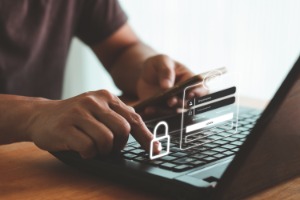What Is Bank Fraud? How To Respond When It Happens
8/22/23 | Kinsey Love, Digital Marketing Manager
 What Is Bank Fraud?
What Is Bank Fraud?
Unfortunately, wherever money or value can be found, thieves are sure to follow. Scammers are always looking for new ways to steal, both from individuals as well as entire business entities. It’s vital to understand the techniques these would-be robbers employ, that way you and your business can be better protected from financial harm.
A common theme in financial theft is the use of bank fraud, a financial crime that involves a financial institution or its services for personal gain or to commit other criminal activities. Bank fraud comes in many shapes and sizes and uses various techniques like false accounts, stolen credit cards, wire fraud, and more.
Types of Bank Fraud
Here are the most common types of bank fraud:
Account Takeover
As you can imagine by the name of this technique, account takeover happens when a fraudster takes over the account of a person or a business. From there, with control of the finances and their movement, the criminal can manipulate the account to their bidding, usually to drain the funds or direct them to another account they control, out of the victim’s reach.
The following are some examples of how this happens.
- Phishing attacks
- Scammers place links in texts and emails that appear to be from legitimate people/businesses but take you to a fraudulent site when opened. This is a deception that can put vital information in the wrong hands.
- Credential stuffing
- This happens when an attacker attempts to gain unauthorized access to a protected account using compromised credentials.
- Cybersecurity issues
- These can include ransomware, malware, cloud vulnerabilities, and other forms of “hacking.”
- Call center fraud
- Done over the phone or on a virtual chat, fraudster or hacker contacts the call center with stolen information. Unable to determine the legitimacy—or illegitimacy—of the person on the other end, the call center can mistakenly grant access to a harmful party.
- Social engineering
- Using blackmail or some other form of psychological manipulation, hackers use this technique to extract sensitive data or info from a user who may be under some form of duress.
New Account Fraud
This occurs after a fraudster acquires a false or stolen identity and then uses such to open a bank account. This happens with either stolen credentials or compromised passwords or with a combination of fake or real identity information.
Check Fraud
This form of fraud involves the use of—you guessed it—a check. Either by using an unauthorized check or a legitimate check that has been altered, thieves steal money from an individual or a business. This can also be manifested as counterfeit, stolen, or doctored checks.
ATM Skimming
Next time you’re at an ATM, you might want to give the machine—especially the area where the card is inserted—a closer look. By rigging ATMs with hidden recording devices, thieves can steal PINs and other information directly off the card itself. It’s something to consider next time you’re at a bank ATM, gas station, grocery store, or any place ATMs can be found. Those places have all been attacked by ATM skimmers.
ACH Fraud
The Automated Clearing House, or ACH, is a network used to transfer money from one bank account to another. Of course, since money can be found in the network, it can also be abused by scammers. This is why it’s so important to cautiously guard the routing number as well as the digits of your checking and savings accounts.
Real-time/Instant Payment Fraud
Real-time payment tools, such as Venmo, CashApp, Zelle, and Apple Pay are convenient for many situations. However, it’s essential to be certain who you’re giving money to before hitting “Send” on your phone. In most payment types, a customer can recall a payment made in error, however, with instant payment, the transaction is processed in seconds. Likewise, the recipient can withdraw the funds immediately as well.
First-Party Fraud
This form of fraud has much less deception as there is no identity theft or identity misrepresentation. It’s just the account holder, acting as themselves, using an account held in their own name to commit fraud.
Wire Transfer Fraud
Emotion manipulation is a major driver of this form of fraud. Typically, a scammer will pose as a person the victim would trust such as a vendor, company, or even a family member, and request an immediate wire transfer. Often, the fraudster will create the illusion of some sort of emergency to create a sense of urgency and emotion, leading the victim to send the money before they have a chance to collect themselves and think better of the situation.
How To Respond to Bank Fraud and Identity Theft
If you’ve been a victim of bank fraud or identity theft, there are several steps you can take to hopefully restore your funds or at least prevent further theft. You should cancel your compromised credit cards, change your passwords, contact your financial institution, and look into canceling the payment, if possible. You may also consider contacting the authorities or looking into fraud insurance. But of course, insurance is better had before it's needed.
Bank Fraud Prevention Services
Bank fraud and identity theft are enormous sources of stress and discomfort. You can avoid the headache and the time consumption of dealing with fraud with prevention before it happens. Altabank offers fraud prevention services to help protect Utahns from bank fraud and identity theft. You can Learn more here.
ABOUT THE AUTHOR
Kinsey Love is the Digital Marketing Manager at Altabank. She specializes in content creation and strategy and enjoys all activities you can do in the mountains.
